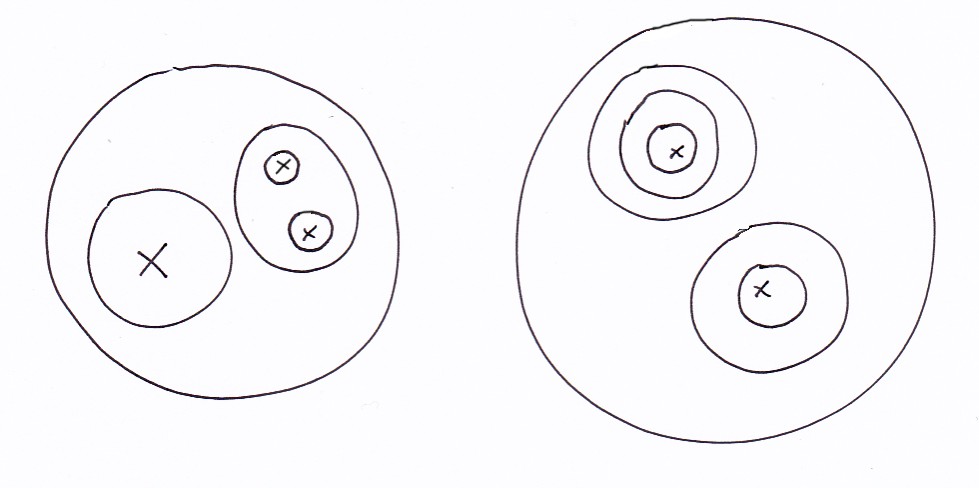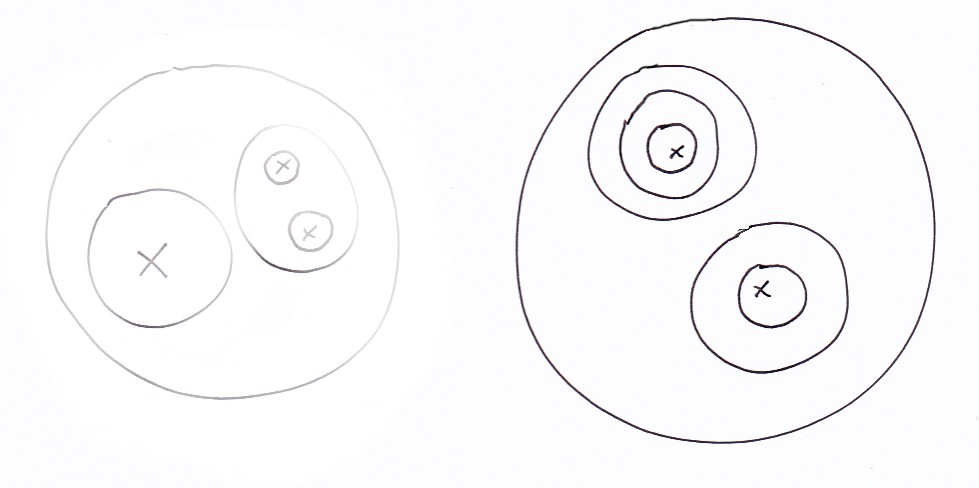How the boy worked out the meaning of any sign
The boy had been to school, a few times, and had brought back a stock of paper and some pencils and a rubber. He was skilled at copying onto paper the patterns made by the forester with his marks on the tree-trunks. Now, he drew a complicated-looking sign on a piece of paper, and explained to his father his fool-proof method for working out what it meant. His explanation went something like this.
In almost any pattern, such as the one I have drawn here (see below), there will be a few empty circles, whose meaning is unequivocal. They are unmarked marks, in other words, valid marks.

Here the five unmarked marks are indicated by little crosses.
In some signs there will be only one empty circle. (Which signs are those?) Only one sign has no empty circles at all - and that is the 'empty sign', which contains no circles at all. A tree carrying the empty sign is completely unmarked and should not be felled. The value of the empty sign is 'no mark'.
A valid mark that is not surrounded by any other circles is 'decisive'. It marks the tree for destruction. A mark, on the other hand, that does lie inside another larger circle, marks the interior of that larger circle and ensures that the surrounding circle is a non-mark, in other words, that it does not count as a mark. As such, the larger circle (and all its contents) can make no contribution to the value of the whole sign. It can neither indicate that the tree must be cut down, nor can it have the effect of marking and thus cancelling a still larger encompassing circle. It will make no difference to the value of the sign simply to rub out the larger circle and its contents. So that is what we do.
In the example given above there are five empty circles. Suppose we select the (leftmost) empty circle, marked by a slightly larger cross, for our special attention. This circle is surrounded by a larger circle; the method dictates that we should rub out that surrounding circle and its contents, thus:

We have reduced the sign to a smaller sign, which we may reduce in turn. We select the uppermost of the two empty circles, and rub out its surrounding circle:

I have drawn in a new cross, indicating that in the new sign we have a new empty circle (thanks to the last bit of rubbing out). For our next step we select this new empty circle for deletion:

Now everything has been rubbed out. No further reduction is possible. Therefore, the original sign that we were given reduces to no mark: its interpretation must be that the tree is to be spared.
It's time for you to try out the boy's method of evaluating any sign for yourself. In the play area (below) start by constructing a sign, of arbitrary complexity. When you are satisfied with what you have made, click on the 'radio button' at bottom right labelled 'Evaluate'. Now find an empty circle and click in it. (If there is no mark, just click anywhere.)Repeat until you arrive at a value.
To carry on, click on the other radio button ('Construct'). The pattern may be modified; or if you want to evaluate the same pattern again, choosing a different sequence of empty circles for deletion, just click again on 'Evaluate'. Over to you...
A feature of the boy's reduction-method is that there is often a choice about which move to make next (i.e. which empty circle to select for deletion); but this never seems to make any difference to the final answer. As he grew up, the boy would confidently maintain, to anyone who was interested, that his method always produced the same answer, when applied to any given sign. But his little sister annoyed him by asking 'How do you know?'. When he tried to give his reasons, the words would never come out right, and his sister would always end up by saying 'I don't think that's much of a reason'. In the end he was so exasperated that he snapped back at her 'Well, see if you can do any better!' - which is exactly what, after a decent interval, she did.
continue to next page...to find out what the girl discovered
back to Once upon a time...